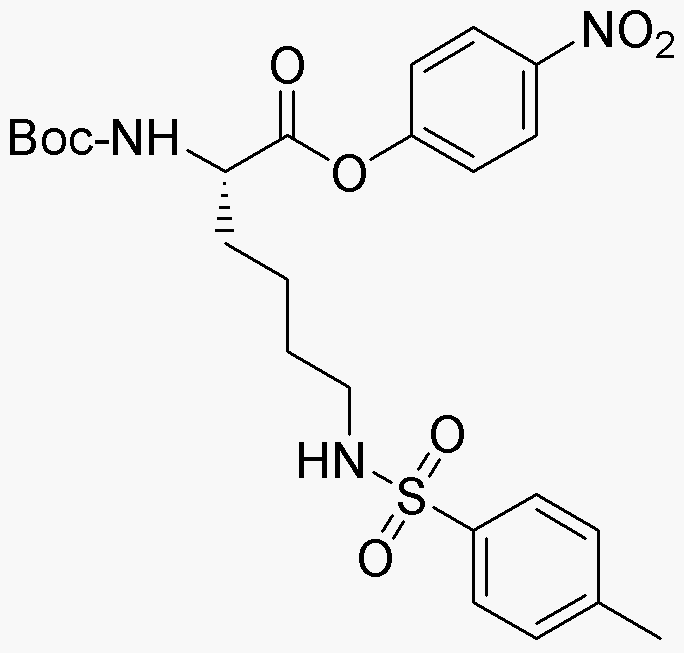Na-Boc-Ne-4-toluenesulfonyl-L-lysine 4-nitrophenyl ester is widely utilized in research focused on:
- Peptide Synthesis: This compound serves as a key building block in the synthesis of peptides, allowing researchers to create complex structures efficiently. Its protective groups facilitate selective reactions, making it ideal for custom peptide production.
- Drug Development: In pharmaceutical research, it is used to develop novel drug candidates. By modifying the compound, scientists can explore new therapeutic options, particularly in targeting specific diseases.
- Bioconjugation: The compound is valuable in bioconjugation techniques, where it helps attach biomolecules to surfaces or other compounds. This application is crucial in creating targeted drug delivery systems and diagnostic tools.
- Protein Engineering: It plays a role in protein engineering, enabling the modification of proteins to enhance their stability or activity. This is particularly beneficial in developing enzymes for industrial applications.
- Research in Chemical Biology: The compound is utilized in chemical biology studies to probe biological systems. Its unique structure allows researchers to investigate enzyme mechanisms and cellular processes effectively.
General Information
Properties
Safety and Regulations
Applications
Na-Boc-Ne-4-toluenesulfonyl-L-lysine 4-nitrophenyl ester is widely utilized in research focused on:
- Peptide Synthesis: This compound serves as a key building block in the synthesis of peptides, allowing researchers to create complex structures efficiently. Its protective groups facilitate selective reactions, making it ideal for custom peptide production.
- Drug Development: In pharmaceutical research, it is used to develop novel drug candidates. By modifying the compound, scientists can explore new therapeutic options, particularly in targeting specific diseases.
- Bioconjugation: The compound is valuable in bioconjugation techniques, where it helps attach biomolecules to surfaces or other compounds. This application is crucial in creating targeted drug delivery systems and diagnostic tools.
- Protein Engineering: It plays a role in protein engineering, enabling the modification of proteins to enhance their stability or activity. This is particularly beneficial in developing enzymes for industrial applications.
- Research in Chemical Biology: The compound is utilized in chemical biology studies to probe biological systems. Its unique structure allows researchers to investigate enzyme mechanisms and cellular processes effectively.
Documents
Safety Data Sheets (SDS)
The SDS provides comprehensive safety information on handling, storage, and disposal of the product.
Product Specification (PS)
The PS provides a comprehensive breakdown of the product’s properties, including chemical composition, physical state, purity, and storage requirements. It also details acceptable quality ranges and the product's intended applications.
Certificates of Analysis (COA)
Search for Certificates of Analysis (COA) by entering the products Lot Number. Lot and Batch Numbers can be found on a product’s label following the words ‘Lot’ or ‘Batch’.
*Catalog Number
*Lot Number
Certificates Of Origin (COO)
This COO confirms the country where the product was manufactured, and also details the materials and components used in it and whether it is derived from natural, synthetic, or other specific sources. This certificate may be required for customs, trade, and regulatory compliance.
*Catalog Number
*Lot Number
Safety Data Sheets (SDS)
The SDS provides comprehensive safety information on handling, storage, and disposal of the product.
DownloadProduct Specification (PS)
The PS provides a comprehensive breakdown of the product’s properties, including chemical composition, physical state, purity, and storage requirements. It also details acceptable quality ranges and the product's intended applications.
DownloadCertificates of Analysis (COA)
Search for Certificates of Analysis (COA) by entering the products Lot Number. Lot and Batch Numbers can be found on a product’s label following the words ‘Lot’ or ‘Batch’.
*Catalog Number
*Lot Number
Certificates Of Origin (COO)
This COO confirms the country where the product was manufactured, and also details the materials and components used in it and whether it is derived from natural, synthetic, or other specific sources. This certificate may be required for customs, trade, and regulatory compliance.


